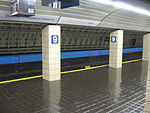Electric Lady Studios

Electric Lady Studios is a recording studio in Greenwich Village, New York City. It was commissioned by rock musician Jimi Hendrix in 1968 and designed by architect John Storyk and audio engineer Eddie Kramer by 1970. Hendrix spent only ten weeks recording in Electric Lady before his death that year, but it quickly became a famed studio used by many top-selling recording artists from the 1970s onwards, including Led Zeppelin, Stevie Wonder, and David Bowie. At the turn of the 21st century, Electric Lady served as a home for the innovative Soulquarians collective, but fell into financial hardship and disarray in the 2000s. Taken over and renovated by investor Keith Stoltz and studio manager Lee Foster, the studio returned to form as a popular location for mainstream artists of the 2010s, such as U2, Kanye West, and Lady Gaga.
Excerpt from the Wikipedia article Electric Lady Studios (License: CC BY-SA 3.0, Authors, Images).Electric Lady Studios
B 83, Rinteln Steinbergen
Geographical coordinates (GPS) Address Website Nearby Places Show on map
Geographical coordinates (GPS)
| Latitude | Longitude |
|---|---|
| N 40.733055555556 ° | E -73.998888888889 ° |
Address
Erlebniswelt steinzeichen steinbergen
B 83
31737 Rinteln, Steinbergen
Niedersachsen, Deutschland
Open on Google Maps





